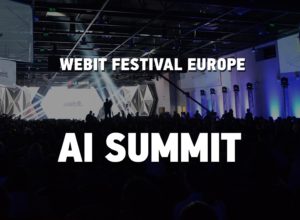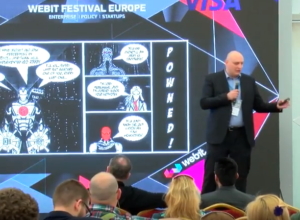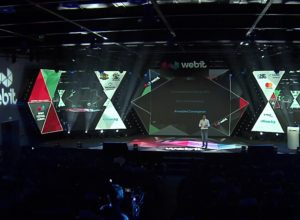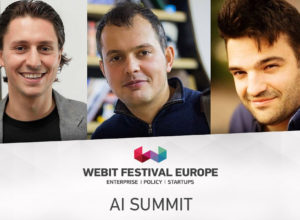Tag: Artificial Intelligence
Humanistic Trans-humanism
“Some technology solutions may not only erase physical or mental deficits but leave patients better off than ‘able-bodied’ folks. The person who has a dis-ability today may have a super-ability tomorrow.”
Stephen HawkingWhat are the “assistive technologies”?
check the upcoming 👉 Webit.Festival 2018
Simply put, this is a technology that is used to increase, maintain, or improve the functional capabilities of people with disabilities. To give you a quick glimpse into understanding, the name Stephen Hawking would help. Hawking has experimented with numerous technologies of this kind. He has communicated using a spelling card, indicating letters and forming words with a lift of his eyebrows. Then, with the help of a computer program allowing him to select words and commands using a hand clicker linked to a speech synthesizer, he has obtained a voice. By moving a single muscle on his cheek and selecting characters from a software screen keyboard, he is able to deliver his thoughts. Normally, one would say that such technology is good for people with disabilities. That way they can:- continue learning or
- be able to maintain a profession.
Technology has played an immense role in helping scientists invent different devices in order to help people with disabilities.
There are hearing devices already put in use, eye tracking and brain controlled interfaces that help to communicate with a computer. Developments towards making artificial retinal implant that can restore lost vision, cars for blind people, exoskeletons assisting people with movement difficulties, enhanced learning for people with learning disabilities that measures and stimulates the brain’s activity. And the big top: brain computer interfaces - a direct communication pathway between an enhanced or wired brain and an external device. The use and progress of Artificial Intelligence is a big stake in improving people’s lives but the thing is that these technologies are being constantly developed and people have benefited from this but these same people are not so many at all 60% of the people are afraid of the progress in AI and robotics. How much will they develop? Will the scenarios from almost all Hollywood movies on the theme shift to reality? We will just have to wait till 2045 and see if Ray Kurzweil’s prediction about the Singularity Point will turn up to be true and whether AI will be developed to such an extent that we’ll be able to merge with it. Watch the full keynote of Maurice Grinberg, Director of HiLab for getting a wider perspective on what AI is here: [embed]https://www.youtube.com/watch?v=ZYPrwZqE9vo[/embed]Risk assessment is dead! Be risk aware.
Let’s put a cyber security smile on the face of your top docs.
In his presentation @Webit.Festival Europe, Boris Goncharov, a leading cyber security strategist, explained a rather boring subject - cyber security threats. And he did it with a story and fictional characters that he created himself! Boris Goncharov’s character - Captain Ciso, is the great defender of the Business city - the city where all the capital is - human, money, business doing, whatever. While he used to save data, defend the city and its citizens from malware, the situation is changed now. One the one hand, the villains express your organisation’s vulnerability. Next the Business city is attacked by bots and the worst type of threat is the very invisible one that never leaves traces and you never it was ever there. The city entered the 21st century. So did the Captain - along with Artificial intelligence on his side, he started using the combination of CMA - DTA - CDSS. This is the logic of the cyber security management of the future. This is the newest way to defeat your cyber security operations and will allow you to continue to monitor, correlate the state of these controls with the external environment. In order to do all this, you need to be aware of the external environment - a common mistake that everybody does - not making a risk evaluation. Once done, this brings nothing but knowledge - action needs to be taken, because threats are all around us. That’s why it’s vital to understand the correlation between your environment and what you can do. The solutions don’t change as much as the treats do. Risk assessment is dead! Today we have to be risk aware every minute. You can watch the full keynote of the captain here: [embed]https://www.youtube.com/watch?v=bNs_YFhe19c[/embed] If you want to stay up to date with the latest trends in security and privacy, Webit.Festival Sofia 2018 is the place for that. Visit our website and check the different ticket options.The symbiosis between humans and machines is our best hope for...
When we are looking towards the future, we usually think about Artificial Intelligence as something that will bring us autonomous vehicles, clean and safe environment and healthy and extended life. Everything we have envisioned is connected to the AI.
But most of us still don’t realize how this amazing technology will be able to change our lives for the better and connect us in a way we didn’t think was possible.
During Webit.Festival Europe the Partner at IBM Ventures Christoph Auer-Welsbach shared his experience in this emerging field and explained why AI in its essence is a converging technology and enabler of the full human potential.
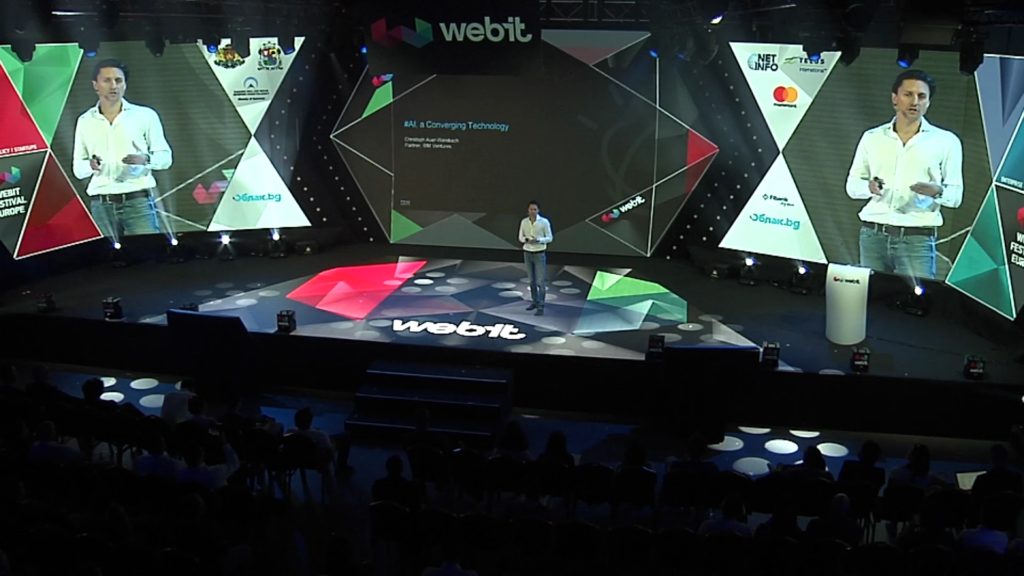 The Partner at IBM Ventures Christoph Auer-Welsbach.[/caption]
Christoph Auer-Welsbach predicts that there are 3 paradigms that are going to shape our communication with AI enabled computers in the near future.
The first is that enterprise applications and all the major IT organizations in the world will make use of any kind of conversation methodology, bot or automating systems, in the next couple of years. So our whole way of interacting with machines is going to change from input-driven to engagement and conversation-driven.
The second paradigm AI is pushing is mass individualization. Now we are living in a world where applications and solutions are built to satisfy the most common and homogenous group of people and reach them. The mass standardization we can see now is changing to mass personalization in a way that not only from a customer service view, but also from a product development and engagement point of view machines will be very much personalized on a person’s behavior, demand and attitude.
The third is that we are moving to the world of AI-enabled Convergence. It enables other technologies to flourish and get into the system contextual information and act proactively and not from a passive response point of view.
Artificial Intelligence is still in its infancy. That is why we need to be active and have the curiosity to understand what it is. It is important for every person on Earth to check the latest trends in this technology and understand how it could impact our personal and business life.
The Partner at IBM Ventures Christoph Auer-Welsbach.[/caption]
Christoph Auer-Welsbach predicts that there are 3 paradigms that are going to shape our communication with AI enabled computers in the near future.
The first is that enterprise applications and all the major IT organizations in the world will make use of any kind of conversation methodology, bot or automating systems, in the next couple of years. So our whole way of interacting with machines is going to change from input-driven to engagement and conversation-driven.
The second paradigm AI is pushing is mass individualization. Now we are living in a world where applications and solutions are built to satisfy the most common and homogenous group of people and reach them. The mass standardization we can see now is changing to mass personalization in a way that not only from a customer service view, but also from a product development and engagement point of view machines will be very much personalized on a person’s behavior, demand and attitude.
The third is that we are moving to the world of AI-enabled Convergence. It enables other technologies to flourish and get into the system contextual information and act proactively and not from a passive response point of view.
Artificial Intelligence is still in its infancy. That is why we need to be active and have the curiosity to understand what it is. It is important for every person on Earth to check the latest trends in this technology and understand how it could impact our personal and business life.
“We now use AI in situations where we didn’t have any solution yet - where technology is not capable of achieving specific results. We are putting a lot of efforts, time and resources to get there. What we have proved already is that we can solve complex, but narrow problems”, he said.The first demonstration of a machine that was capable of solving a complex problem was in 1997 when IBM’s Deep Blue defeated Garry Kasparov in chess. Roughly 15 years later a team in IBM Research had the goal to understand natural human language. The public demonstration was to defeat a human at the show Jeopardy and this was accomplished. Another thing that happened last year was Alpha Go from Google DeepMind defeating Lee Sedol in the boardgame Go and also succeeding to solve a very complex problem in a very narrow domain. And just recently a team from Carnegie Mellon University succeeded in developing a smart machine that has defeated world class poker players in Texas Hold ‘Em because it can already understand and deal with incomplete information. This all means that the future goes into the direction where AI will be used for negotiation processes, strategy development and even high level policy analytics.
“When you go to your car dealer in the future you may have a small application on your device that helps you negotiate the best possible deal”, Auer-Welsbach said.The biggest issue before the AI today is understanding humans and language. The machines understand natural text as data, not as text. This is a problem, because they are missing the context, which is necessary in order to really make use of all the data. In a recent attempt IBM broke industry record in conversation speech recognition by getting it down to 5.5%. This is important because the human error is at 5.1% which means that we are very close to understanding the natural human language from a machine perspective. This new ability can be used to build transformative relationships between humans and machines. [caption id="attachment_5072" align="aligncenter" width="640"]
 The Partner at IBM Ventures Christoph Auer-Welsbach.[/caption]
Christoph Auer-Welsbach predicts that there are 3 paradigms that are going to shape our communication with AI enabled computers in the near future.
The first is that enterprise applications and all the major IT organizations in the world will make use of any kind of conversation methodology, bot or automating systems, in the next couple of years. So our whole way of interacting with machines is going to change from input-driven to engagement and conversation-driven.
The second paradigm AI is pushing is mass individualization. Now we are living in a world where applications and solutions are built to satisfy the most common and homogenous group of people and reach them. The mass standardization we can see now is changing to mass personalization in a way that not only from a customer service view, but also from a product development and engagement point of view machines will be very much personalized on a person’s behavior, demand and attitude.
The third is that we are moving to the world of AI-enabled Convergence. It enables other technologies to flourish and get into the system contextual information and act proactively and not from a passive response point of view.
Artificial Intelligence is still in its infancy. That is why we need to be active and have the curiosity to understand what it is. It is important for every person on Earth to check the latest trends in this technology and understand how it could impact our personal and business life.
The Partner at IBM Ventures Christoph Auer-Welsbach.[/caption]
Christoph Auer-Welsbach predicts that there are 3 paradigms that are going to shape our communication with AI enabled computers in the near future.
The first is that enterprise applications and all the major IT organizations in the world will make use of any kind of conversation methodology, bot or automating systems, in the next couple of years. So our whole way of interacting with machines is going to change from input-driven to engagement and conversation-driven.
The second paradigm AI is pushing is mass individualization. Now we are living in a world where applications and solutions are built to satisfy the most common and homogenous group of people and reach them. The mass standardization we can see now is changing to mass personalization in a way that not only from a customer service view, but also from a product development and engagement point of view machines will be very much personalized on a person’s behavior, demand and attitude.
The third is that we are moving to the world of AI-enabled Convergence. It enables other technologies to flourish and get into the system contextual information and act proactively and not from a passive response point of view.
Artificial Intelligence is still in its infancy. That is why we need to be active and have the curiosity to understand what it is. It is important for every person on Earth to check the latest trends in this technology and understand how it could impact our personal and business life.
“The symbiosis between humans and machines is the most capable way of making use of technology and moving forward into the future. Because we can enhance each other’s capabilities. On the one hand we have human’s capabilities like compassion, intuition and value judgement and on the other we have the learning, discovery and fact checking that machines excel at”, the expert said.You may watch Christoph Auer-Welsbach’s full lecture here: If you want to keep up with the latest trend in the world of digital economy and technology, then Webit.Festival is the right place for you. Visit our website and book 2 of our Super Earlybird tickets for Webit.Festival Europe 2018 for just €100. Feel the Webit vibe with some of the best photos from this year’s event! [easingslider id="4954"]
Come to Webit.Festival and see the latest advancements in AI
Last year was full of AI technology advancements, but in 2017 experts and big players in this innovative field expect even more.
Probably the biggest success was the historic victory of AlphaGo over one of the best Go players in history Lee Sedol. This was the factual presentation to the world of the positives, that the process called deep reinforcement learning can bring.
“Reinforcement learning takes inspiration from the ways that animals learn how certain behaviors tend to result in a positive or negative outcome. Using this approach, a computer can, say, figure out how to navigate a maze by trial and error and then associate the positive outcome—exiting the maze—with the actions that led up to it. This lets a machine learn without instruction or even explicit examples”, explained the senior editor at MIT Technology Review Will Knight.In 2017, we are likely to see attempts to apply reinforcement learning to problems such as automated driving and industrial robotics. If the outcome is positive, this could completely change transport and manufacturing. At this year’s Webit.Festival Europe you can listen to some of the top experts in the world of artificial intelligence and machine learning. During the AI Summit they will share their expectations about the development of this amazing field of science and technology. The Partner at IBM Ventures Christoph Auer-Welsbach will speak about Deep Tech and AI and will share the best practices for high-growth startups on going from tested idea to scalable company. He will advise the audience how to apply artificial intelligence techniques in products and business. ARX’s Founder and CEO Mark Val will explain how augmented reality and artificial intelligence are transforming remote collaboration and are creating a profound sense of presence and interaction between remote teams. In his speech he will share how transition is currently happening and the impact of it. The Director of Strategic and International Development at Wolfram Research Conrad Wolfram will give his recipe for fixing current education through artificial intelligence. He is recognized as a world authority on fixing maths education, including advocating a fundamental shift to focus on computer-based computational thinking rather than hand calculation. IBM’s Vice President for Cloud and Mobile Technology Jonas Jacobi will tell us what we can learn from AI, Cloud Computing and IoE and will help us realize the power of the combination of these new technologies. The CEO and Founder of Augmented Pixels Vitaliy Goncharuk will talk about the development of augmented reality and the connection between it and the progress in the field of artificial intelligence. Meanwhile, the Chief Software Architect of Google’s Quantum Artificial Intelligence Lab Vasil Denchev will explain the primary mission of artificial intelligence - to build good models of the world around us and automatically make accurate predictions for various task of practical importance. Here you can see a full list of the confirmed speakers at Webit.Festival, while here you can get all the information you need about the tickets for the event.
